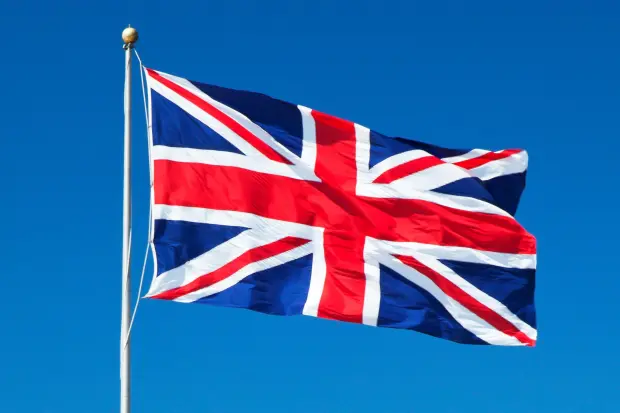Queen’s funeral: Flags back at full-mast as mourning period ends
Flags on British government buildings around the world are flying at full-mast once again, as the period of national mourning following the death of Queen Elizabeth II draws to a close.
The Queen was buried in a private ceremony in Windsor on Monday evening, following a state funeral in London and military procession to Windsor Castle.
But the Royal Family will continue to observe another week of mourning.
Senior royals are not expected to carry out any public duties during this time.
Flags at royal residences will remain at half-mast until 08:00 BST on 27 September – the day after their mourning period ends.
Buckingham Palace has said royal household staff, representatives of the household on official duties and troops committed to ceremonial duties will also observe the extended mourning.
A clean-up operation is under way after hundreds of thousands of people across the UK flocked to London to watch the Queen’s funeral.
Council workers wearing black ribbons and bows were deployed to pick up litter and remove sand on roads around Westminster.
Cleaners at Southwark Council in south London worked an extra 24 hours during the time mourners queued to visit the Queen lying-in-state – removing seven tonnes of rubbish in the process.
On Monday, world leaders and foreign royalty joined a 2,000-strong congregation at Westminster Abbey for the funeral, where the Dean of Westminster paid tribute to her “lifelong sense of duty”.
Archbishop of Canterbury Justin Welby spoke of the affection so many people felt for the late monarch. “Few leaders receive the outpouring of love we have seen,” he added.
About 100 presidents and heads of government were in the abbey – including US President Joe Biden, French President Emmanuel Macron, New Zealand Prime Minister Jacinda Ardern, and Canadian PM Justin Trudeau.
Royal families from around the globe also attended – with kings, queens and emperors from Denmark, Spain, Sweden, Norway, Belgium, the Netherlands, Japan, Malaysia and Jordan present.
After the funeral, the Queen’s coffin was taken by gun carriage to Wellington Arch in London and then on to its final journey via funeral cortege, along a route that avoided motorways to allow as many as possible to pay their final respects.
Many thousands of people lined the streets to see the procession taking her coffin to to Windsor Castle and a committal service.
As a day of spectacle and mourning drew to a close, the UK’s longest-reigning monarch was laid to rest alongside her late husband the Duke of Edinburgh and in the King George VI Memorial Chapel, found inside St George’s Chapel in Windsor.
The scale of the funeral and mourning arrangements over the 10-day period, which included a miles-long queue snaking along the south bank of the River Thames to see the Queen’s lying-in-state, led to what police described as “probably the biggest operation we’re likely to launch in the UK”.
With thousands flocking into central London and dignitaries from around the world gathering to pay their respects, the funeral represented the “final and most complex phase” of the operation, the Metropolitan Police has said.
More than 3,000 officers from almost every force in the country were in London to help with the security for the funeral, including snipers stationed on rooftops and armed police, horseback teams and other specialist units patrolling the streets.
There were 67 arrests made on Monday as part of that police operation for a range of offences.
Hundreds of thousands of people queued to visit the Queen lying-in-state in Westminster Hall, with some mourners waiting all night to pay tribute.
Culture Secretary Michelle Donelan said the government was crunching the final figures, but at least 250,000 people are estimated to have stood in line to pay their respects.
She told BBC Breakfast: “The queue was phenomenal. It was a real team effort to enable people to have that moment to say goodbye. I want to thank everyone involved.”
Prime Minister Liz Truss said that she was “hugely honoured” to have been invited to form a government by the late Queen in her final days.
She spoke of the “outpouring of love and warmth” towards Elizabeth II, adding the events since her death had been a fitting tribute.
Speaking to the BBC’s political editor Chris Mason in New York, she said: “I think the work that’s been done by the civil service, by the Royal Household on the funeral, has really paid fitting tribute to somebody who contributed so much to the modern world – not just in Britain, but right, right around the world.”
The royal galleries will reopen later this week while the Royal Family continues mourning for another week.
During this time, the Royal Family will not do any public engagements unless the King gives special permission.
The Queen’s Gallery at Buckingham Palace in central London, the Palace of Holyroodhouse and the Queen’s Gallery in Edinburgh will all reopen to visitors on Thursday.



